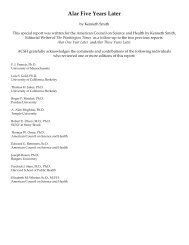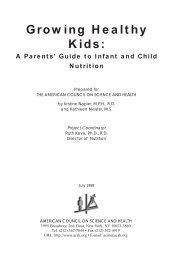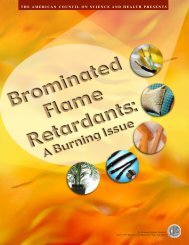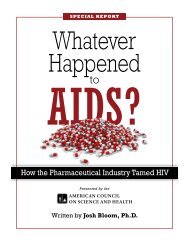The Role of Beef in the American Diet - International Meat Secretariat
The Role of Beef in the American Diet - International Meat Secretariat
The Role of Beef in the American Diet - International Meat Secretariat
You also want an ePaper? Increase the reach of your titles
YUMPU automatically turns print PDFs into web optimized ePapers that Google loves.
<strong>The</strong> <strong>Role</strong> <strong>of</strong> <strong>Beef</strong> <strong>in</strong> <strong>the</strong> <strong>American</strong> <strong>Diet</strong><br />
III. Positive Contributions <strong>of</strong> <strong>Beef</strong> to <strong>the</strong> <strong>Diet</strong><br />
M<strong>in</strong>erals<br />
Red meats — especially beef — are richer <strong>in</strong> some nutrients, particularly<br />
z<strong>in</strong>c and iron, than most <strong>of</strong> <strong>the</strong> o<strong>the</strong>r foods <strong>in</strong> <strong>the</strong> <strong>Meat</strong>, Poultry,<br />
Fish, Dry Beans, Eggs, and Nuts Group (<strong>Meat</strong> Group for short) <strong>of</strong> <strong>the</strong><br />
Food Guide Pyramid.<br />
Z<strong>in</strong>c is <strong>in</strong>volved <strong>in</strong> many functions <strong>in</strong> <strong>the</strong> human body, <strong>in</strong>clud<strong>in</strong>g<br />
growth, maturation, immunity, wound heal<strong>in</strong>g, reproduction, and <strong>the</strong><br />
senses <strong>of</strong> taste and smell. Z<strong>in</strong>c deficiency is a major problem worldwide,<br />
and even <strong>in</strong> <strong>the</strong> U.S., some people’s <strong>in</strong>takes <strong>of</strong> this m<strong>in</strong>eral may<br />
be too low. A comparison <strong>of</strong> 1994–98 national dietary survey data with<br />
<strong>the</strong> Recommended <strong>Diet</strong>ary Allowances (RDAs) for z<strong>in</strong>c established <strong>in</strong><br />
2001 showed that at least 40% <strong>of</strong> adolescent girls and adult women are<br />
not meet<strong>in</strong>g <strong>the</strong> z<strong>in</strong>c RDA (2). About 60 percent <strong>of</strong> men over <strong>the</strong> age <strong>of</strong><br />
70 also consume less than <strong>the</strong> recommended amount <strong>of</strong> z<strong>in</strong>c.<br />
Gett<strong>in</strong>g enough z<strong>in</strong>c may be especially difficult for vegetarians<br />
because substances <strong>in</strong> plant foods, such as phytate, <strong>in</strong>terfere with <strong>the</strong><br />
body’s ability to make use <strong>of</strong> z<strong>in</strong>c from food. <strong>The</strong> plant foods that are<br />
richest <strong>in</strong> z<strong>in</strong>c, such as legumes, whole gra<strong>in</strong>s, seeds, and nuts, are also<br />
high <strong>in</strong> phytate (3). <strong>The</strong> requirement for z<strong>in</strong>c <strong>in</strong>take may be as much as<br />
50% higher for vegetarians than for o<strong>the</strong>r people (4).<br />
<strong>Beef</strong> is one <strong>of</strong> <strong>the</strong> best food sources <strong>of</strong> z<strong>in</strong>c. A s<strong>in</strong>gle 3-oz. serv<strong>in</strong>g<br />
<strong>of</strong> lean beef provides at least one-fourth <strong>of</strong> <strong>the</strong> Daily Value <strong>of</strong> this m<strong>in</strong>eral.<br />
<strong>The</strong> z<strong>in</strong>c <strong>in</strong> beef and o<strong>the</strong>r foods <strong>of</strong> animal orig<strong>in</strong> is more bioavailable<br />
than <strong>the</strong> z<strong>in</strong>c <strong>in</strong> plant foods (3). Because beef is high <strong>in</strong> z<strong>in</strong>c and is<br />
frequently consumed, it is <strong>the</strong> number one source <strong>of</strong> z<strong>in</strong>c <strong>in</strong> <strong>the</strong> U.S.<br />
diet, account<strong>in</strong>g for 26 and 22% <strong>of</strong> <strong>the</strong> total z<strong>in</strong>c <strong>in</strong>take <strong>of</strong> adults and<br />
children, respectively (5,6). Table 1 compares <strong>the</strong> z<strong>in</strong>c content <strong>of</strong> beef<br />
with that <strong>of</strong> o<strong>the</strong>r animal products from <strong>the</strong> <strong>Meat</strong> Group.<br />
Iron is essential for transport<strong>in</strong>g oxygen <strong>in</strong> <strong>the</strong> bloodstream; <strong>in</strong>sufficient<br />
<strong>in</strong>takes can lead to iron-deficiency anemia and to impaired cognitive<br />
development <strong>in</strong> <strong>in</strong>fants and young children. Adolescent girls and<br />
women <strong>of</strong> childbear<strong>in</strong>g age have a greater need for iron than o<strong>the</strong>r people<br />
do because <strong>the</strong>y lose iron every month dur<strong>in</strong>g menstruation. <strong>The</strong>y,<br />
along with young children, need plenty <strong>of</strong> good iron sources <strong>in</strong> <strong>the</strong>ir<br />
diets (8). Adult men and postmenopausal women, on <strong>the</strong> o<strong>the</strong>r hand,<br />
have lower needs for iron and rarely have difficulty meet<strong>in</strong>g those<br />
needs. A comparison <strong>of</strong> national dietary survey data from 1994–1998<br />
with <strong>the</strong> RDAs for iron established <strong>in</strong> 2001 showed that 25% <strong>of</strong> children<br />
age 5 and younger (both sexes), 60% <strong>of</strong> adolescent girls (ages<br />
9










